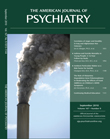Identification and Treatment of a Pineal Region Tumor in an Adolescent With Prodromal Psychotic Symptoms
Abstract
An adolescent male patient originally presented to a prodromal clinical research program with severe obsessive-compulsive behaviors and subthreshold symptoms of psychosis, which eventually developed into first-rank psychotic symptoms. The patient was followed over a 2-year period. His symptoms did not respond to psychotherapy or pharmacotherapy. However, when a pineal region tumor was discovered and treated with chemotherapy and autologous stem cell rescue, both psychotic symptoms and psychosocial functioning reverted toward baseline. Although subcortical brain structures have been implicated in the pathophysiology of idiopathic psychosis, reports of psychiatric sequelae of treatment of subcortical tumors are rare. Etiological pathways that may have played a role in symptom development are of particular interest, as understanding these mechanisms may shed light on the pathophysiology of psychotic disorders more generally.



